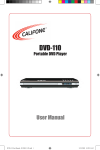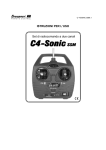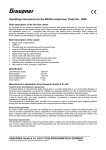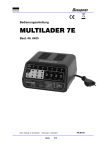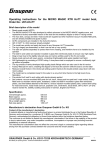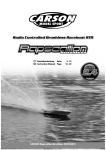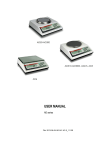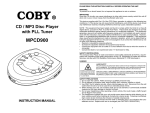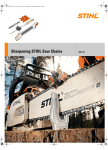Download Operating Instructions for the Scharnhorst model ship
Transcript
Operating Instructions for the Scharnhorst model ship, Order No.: 2091 History of the full-size vessel • • • • Accurate scale model of the former German War Navy’s battle cruiser of 1936. The Scharnhorst and her sister ship Gneisenau were the first warships to be built which significantly exceeded the specifications laid down by the Treaty of Versailles. To avoid provoking a conflict with England, the vessels were fitted with the relatively weak armament of 28 cm guns, although they carried powerful armour and had a high top speed of 31.5 kn. Nevertheless the ships were not legalised until the signing of the German-British Fleet Agreement. In the period up to 1942 the two ships participated in a number of joint operations against merchant shipping, and in support of the German occupation of Norway. After their return to Germany (Operation Cerberus) the Gneisenau lay in dock for the repair of relatively slight mine damage, when she was severely damaged in an aerial attack, and was never re-commissioned. In 1945 the vessel was scuttled as part of the blockade of the entrance to Gotenhafen. In December 1943, during an operation (Operation Ostfront) in the North Sea against merchant shipping, the Scharnhorst was sunk by two British battle groups consisting of the battleship HMS Duke of York, three light cruisers, one heavy cruiser and eight destroyers. In September 2000, after protracted research by the Norwegian Alf R. Jacobsen in British, German and Norwegian military archives, and interviews with survivors and surviving dependents, the wreck of the Scharnhorst was located at a depth of around 300 m, at a point around 160 km North of Nordkap. The model This boat is a member of the GRAUPNER PREMIUM line, a series of particularly high-quality ready-made models with an unprecedented level of detailing. The core of this high-quality model is the robust moulded GRP hull, complemented by the superstructure and deck which are constructed from laser-cut ABS parts. Many of the small items are of metal, and almost everything is factory-assembled. The hull, parts of the superstructure, the masts and fittings are spray-finished using semi-matt paints, and the decals are already applied. The many details and scale fittings give the boat an impressive scale appearance. The large deck opening makes it a simple matter to install the RC components, and the procedure is quickly completed. To prepare the boat for running all you have to do is install the RC components and the drive battery, carry out a little soldering, and the model is ready for the water. Specification Length approx. Beam approx. Overall height approx. All-up weight incl. RC approx. Scale approx. 1580 mm 205 mm 405 mm 9.5 kg 1 : 150 Manufacturer’s declaration from Graupner GmbH & Co KG Contents of the manufacturer’s declaration: If material defects or manufacturing faults should arise in a product distributed by us in the Federal Republic of Germany and purchased by a consumer (§ 13 BGB), we, Graupner GmbH & Co. KG, D73230 Kirchheim/Teck, Germany, acknowledge the obligation to correct those defects within the limitations described below. The consumer is not entitled to exploit this manufacturer’s declaration if the failure in the usability of the product is due to natural wear, use under competition conditions, incompetent or improper use (including incorrect installation) or external influences. This manufacturer’s declaration does not affect the consumer’s legal or contractual rights regarding defects arising from the purchase contract between the consumer and the vendor (dealer). Extent of the guarantee If a claim is made under guarantee, we undertake at our discretion to repair or replace the defective goods. We will not consider supplementary claims, especially for reimbursement of costs relating to the defect (e.g. installation / removal costs) and compensation for consequent damages unless they are GRAUPNER GmbH & Co. KG D-73230 KIRCHHEIM/TECK No liability for printing errors. We reserve the right to introduce modifications. GERMANY #0059636 03/2009 1 llowed by statute. This does not affect claims based on legal regulations, especially according to product liability law. Guarantee requirements The purchaser is required to make the guarantee claim in writing, and must enclose original proof of purchase (e.g. invoice, receipt, delivery note) and this guarantee card. He must send the defective goods to us at his own cost, using the following address: Gliders Brunel Drive, Newark, Nottinghamshire, NG242EG The purchaser should state the material defect or manufacturing fault, or the symptoms of the fault, in as accurate a manner as possible, so that we can check if our guarantee obligation is applicable. The goods are transported from the consumer to us and from us to the consumer at the risk of the consumer. Duration of validity This declaration only applies to claims made to us during the claim period as stated in this declaration. The claim period is 24 months from the date of purchase of the product by the consumer from a dealer in the Federal Republic of Germany (date of purchase). If a defect arises after the end of the claim period, or if the evidence or documents required according to this declaration in order to make the claim valid are not presented until after this period, then the consumer forfeits any rights or claims from this declaration. Limitation by lapse of time If we do not acknowledge the validity of a claim based on this declaration within the claim period, all claims based on this declaration are barred by the statute of limitations after six months from the time of implementation; however, this cannot occur before the end of the claim period. Applicable law This declaration, and the claims, rights and obligations arising from it, are based exclusively on the pertinent German Law, without the norms of international private law, and excluding UN retail law. Important safety notes You have acquired a kit which can be assembled into a fully working RC model when fitted out with suitable accessories. However, we as manufacturers have no control over the way you build and operate your RC model boat, nor how you install, operate and maintain the associated components, and for this reason we are obliged to deny all liability for loss, damage or costs which are incurred due to the incompetent or incorrect use and operation of our products, or which are connected with such operation in any way. Unless otherwise prescribed by binding law, the obligation of the GRAUPNER company to pay compensation, regardless of the legal argument employed, is excluded. This includes personal injury, death, damage to buildings, damage due to loss of business or turnover, interruption of business or other direct or indirect consequent damage whose root cause was the operation of the model. The total liability in all cases is limited to the amount of money which you actually paid for this model. This model boat is built and operated at the sole and express responsibility of the operator. The only way to avoid injury to persons and damage to property is to handle and operate the model with the greatest care and consideration at all times. Before you run the model for the first time please check that your private third-party insurance covers the operation of model boats of this kind. If in doubt, take out a special insurance policy designed to cover modelling risks. These safety notes should be kept in a safe place. If you ever dispose of the model, be sure to pass them on to the new owner. The following points are important and must be observed at all times: • This model is not suitable for young persons under 14 years of age. • The projecting parts of the model may be sharp, and the aerials and masts could cause eye injuries. • Bear in mind that tools can be dangerous; always be careful when handling them. • Never operate the model when there are persons or animals in the water, as its high speed constitutes a considerable injury hazard. • Do not run your model in protected sites, animal or plant sanctuaries or sites of special scientific interest (SSSIs). Check with your local authority that the stretch of water you wish to use is suitable for model boats. GRAUPNER GmbH & Co. KG D-73230 KIRCHHEIM/TECK No liability for printing errors. We reserve the right to introduce modifications. GERMANY #0059636 03/2009 2 • • • • • • • • • • • • • • • • • • • • • • • Never run the boat in salt water. Never run the boat in adverse conditions, e.g. rain, storm, strong wind, choppy water or strong currents. Read the instructions provided with your radio control system and accessories, and observe the recommendations. Before you run the model check that the radio control system is working reliably, and that all connections are secure. Dry batteries must never be recharged. Only batteries marked as “rechargeable” are safe to recharge. Check the range of the radio control system before each session: ask a friend to walk about 100 m away from the model carrying the transmitter. Your friend will be able to tell you whether all the working functions operate correctly at this range. Ensure that the frequency you intend to use is not already in use by other modellers. Never run your boat if you are not certain that your channel is free. Bear in mind that other radio equipment and transmitting stations can cause serious interference to the model. Ensure that no equipment of this type is being used in the vicinity while you are operating the model. Do not carry out any work on the drive train unless you have disconnected and removed the battery. When the drive batteries are connected, keep well clear of the area around the propellers, and make sure any spectators do the same. Do not be tempted to exceed the recommended operating voltage. Higher voltages may cause the motors or speed controller to overheat, and the electrical cables may even melt. If this should happen, the model could easily be ruined. Check that all the drive train components work smoothly and freely. This applies in particular when the boat is running, as leaves and other debris may get caught in the power system components. The motors and speed controller could then be ruined by overloading. Dry cells and rechargeable batteries must never be short-circuited. Do not allow them to come into direct contact with water. Remove the rechargeable batteries and the dry cells in the transmitter and receiver pack if the model is to be transported, or will not be used for a long period. Do not subject the model boat to high levels of humidity, heat, cold or dirt. Secure the model and your RC equipment carefully when transporting them. They may be seriously damaged if they are free to slide about. Never operate the boat in moving water (e.g. a river), as its low speed may result in the model drifting off downstream. If you have to salvage the model, take care not to risk your own life or that of others. Take particular care to ensure that the boat is completely watertight, as it will sink if too much water enters the hull. Check the model for damage before every run, and ensure that water cannot penetrate through the shaft bearings. Allow the boat to dry out thoroughly after each session. Be sure to check repeatedly during the first run that the shaft system is watertight. If water enters the hull through the shaft tube, remove the shaft and lubricate the tube with plenty of grease, Order No. 570. NOTE: it is important not to dispose of the electric motors installed in the model in the ordinary household waste. They must be removed from the boat and taken to the appropriate collection point for electrical waste. NOTE: if you install two drive batteries and wire them in parallel, they should only be connected while you are operating the boat, as inter-actions can occur between the two batteries under no-load conditions, and may cause damage to the packs. It is always best to connect the batteries just before running the model, and then disconnect them immediately afterwards. On no account store the boat with the batteries connected using the parallel lead. Care and maintenance • • • Clean the model carefully after every run, and remove any water which penetrates the hull. If water gets into the RC components, dry them out carefully and send them to your nearest GRAUPNER Service Centre for checking. Clean the model and transmitter using suitable cleaning agents only. All you need is a lint-free cloth. Never use chemical cleaners, solvents, methylated spirits, white spirit or similar. Lubricate the propeller shafts at regular intervals by applying a small drop of oil to the bearings. The external shaft bearing adjacent to the propeller must also be lubricated. Use a type of oil which does not soil or contaminate water, e.g. Order No. 206. At the end of the season we recommend that you remove the propeller shaft and re-lubricate it using water-neutral grease, e.g. Order No. 570. GRAUPNER GmbH & Co. KG D-73230 KIRCHHEIM/TECK No liability for printing errors. We reserve the right to introduce modifications. GERMANY #0059636 03/2009 3 Assembling the model • • • • • • • Carefully unpack the model and the boatstand. To remove the superstructure grasp it carefully by the battle bridge and the rear rangefinder, and lift it up vertically. Solder G2 connectors to the central motor. The outer motors should be wired in parallel, and then soldered to G2 connectors, referring to the wiring diagram on page 6 (+ is red, - is black). Check the direction of rotation of the motors when the battery is connected: the propellers must rotate in such a way that the model would be propelled forward. NOTE: the raised lug on the plastic housing of all G2 connectors should always be the positive terminal (red wire). If you keep consistently to this principle, your batteries and speed controllers will be interchangeable, and the system will be protected against accidental reversed polarity. We recommend that you follow the tips outlined below, which will make it easier to solder the connectors. The procedure described will also help to avoid damaging detail fittings on the model with the hot soldering iron. TIP 1: remove the motors: undo the grubscrews in the propellers so that the propellers can be withdrawn. Now undo the motor retaining screws (don’t remove them completely) and slide the motors forward until the shaft couplings are exposed. Undo the grubscrews in the couplings which clamp the motor shafts, then remove the motors from the model. The motors and propellers can be re-installed simply by reversing the whole procedure. TIP 2: if you have a friend to help you, ask him or her to support the boat at an angle so that you can hold the motor wires outside the hull for soldering; any excess solder will then fall away from the model. TIP 3: a “third hand” is a useful clamping tool which you can use to hold the wires for soldering directly inside the model. Check that the screws in the shaft couplings, the motor retaining bars and the propellers are really tight, as they may have worked loose in transit. You can check this by pulling on the propellers; if you find you can move the shafts to the rear, then one of the grubscrews is loose. Tighten the offending item carefully, using TIP 1 as described above in order to gain access to them. IMPORTANT: if the grubscrews are loose, apply a drop of thread-lock fluid to them, e.g. UHU schraubensicher, Order No. 952, as vibration could cause them to work loose again while the boat is running. Drill out the outer hole in the servo output arm to 2 mm diameter and attach the pushrod connector to it. IMPORTANT: take care not to damage the servo lead by trapping it under one of the screws. TIP: if you are unable to find a drill long enough for this job at your model shop or DIY shop, one solution is to glue (or - better solder) a 1.5 mm Ø drill bit in a length of brass tube with an internal diameter of 1.6 mm Ø (e.g. Order No. 564.3). Set the rudder to ‘Straight forward’ and slide the rudder pushrod in the pushrod connector. The rudder servo must be centred, too and then the rudder pushrod can be tightened. Solder a 20 cm length of twin-core cable to each of the drive batteries, and attach G2 plugs to the free ends. The batteries are secured in the model using Velcro (hook-and-loop) tape. Apply adhesive tape over the terminals to avoid any risk of short-circuits. NOTE: the Velcro tape provides an easy method of adjusting the battery position, in order to achieve the correct fore-and-aft trim. TIP: once you have established the correct trim, mark the position of the batteries using a waterproof felttip pen so that you can be sure of re-installing them in the correct position. GRAUPNER GmbH & Co. KG D-73230 KIRCHHEIM/TECK No liability for printing errors. We reserve the right to introduce modifications. GERMANY #0059636 03/2009 4 • • • • Install the receiver and the speed controller adjacent to the motors using Velcro tape. The receiver aerial should be deployed as close as possible to the superstructure coaming, and fixed in place with strips of adhesive tape. The aerial must be fitted above the waterline, as it will not pick up a signal if it is below the surface. Now assemble the enclosed parts (cannon and crane) as illustrated on the photo. The cranes must not be glued, because otherwise the superstructure can only be detached very hardly. It is up to you to fix the strut emblem by using superglue. NOTE: right after outbreak of the war the strut emblems were demounted and had no longer be used. This is the reason why these parts were packed separately and included in the kit. GRAUPNER GmbH & Co. KG D-73230 KIRCHHEIM/TECK No liability for printing errors. We reserve the right to introduce modifications. GERMANY #0059636 03/2009 5 GRAUPNER GmbH & Co. KG D-73230 KIRCHHEIM/TECK No liability for printing errors. We reserve the right to introduce modifications. GERMANY #0059636 03/2009 6 Wiring diagram Motor Motor Speed controller middle motor G2 connectors 3061 G2 connectors Speed controller outer motors Motor G2 connectors 3061 G2 connectors Servo V-cable 3936.11 to receiver 3061 Drive batterie to particular speed controller Drive batterie 2x Maiden run Charge up all the batteries and test the model’s working systems one by one. Check that all the parts which are not permanently attached are firmly seated. Now you are ready for the boat’s maiden run. Keep the its speed low at first, and give yourself plenty of time to become familiar with its handling. The model has quite a turn of speed, its minimum turning radius is large and its braking distance long. For this reason it should only be operated on a fairly large stretch of water. We hope you have many hours of pleasure running your model of the Scharnhorst. Replacement part Order No. 2091.6 Replacement propeller set (3 off) You will also need the following items (not included in the set) Order No. Description 4729 X-408 ECO-SPORT SYSTEM FM RC set, 40 MHz or 4714 X-412 FM RC set, 40 MHz 2875 NAVY V40R speed controller (two required) 769 Lead-acid drive battery, 6 V / 4 Ah (four required) 3061 G2 parallel lead (two required) 2989.5 G2 connector system for the speed controller and drive batteries 3389 High-flex copper cable, red / black, each 1 m long 3368 Velcro (hook-and-loop) tape 3936.11 Y-lead 1177 Link socket (one required) GRAUPNER GmbH & Co. KG D-73230 KIRCHHEIM/TECK No liability for printing errors. We reserve the right to introduce modifications. GERMANY #0059636 03/2009 7








